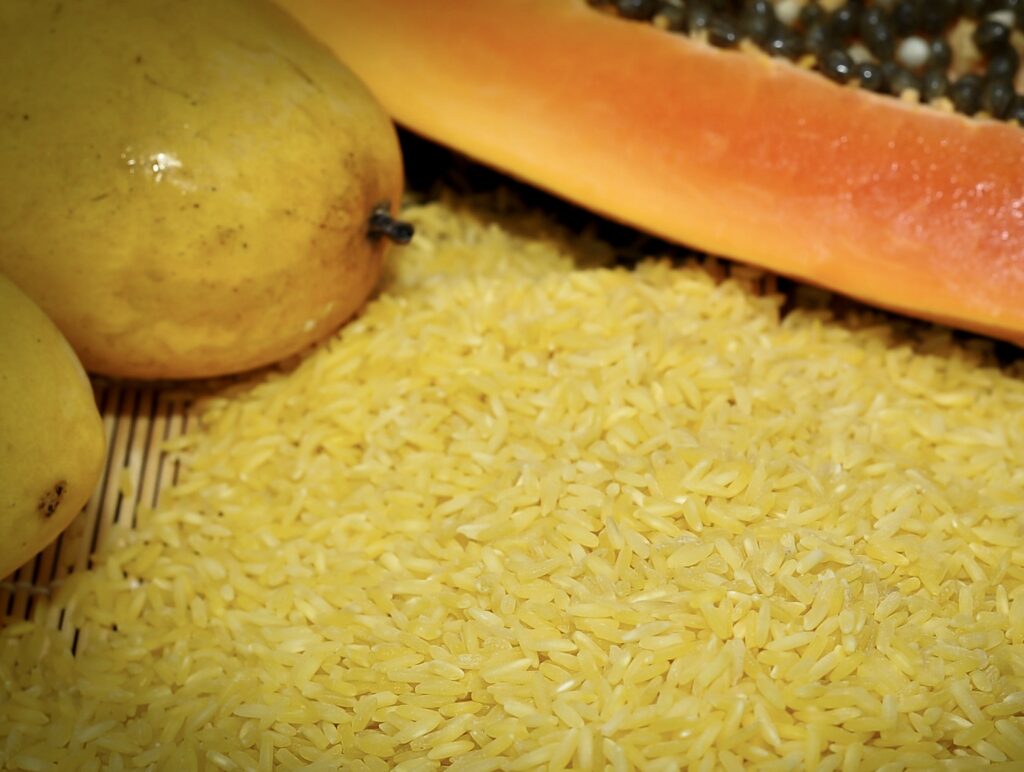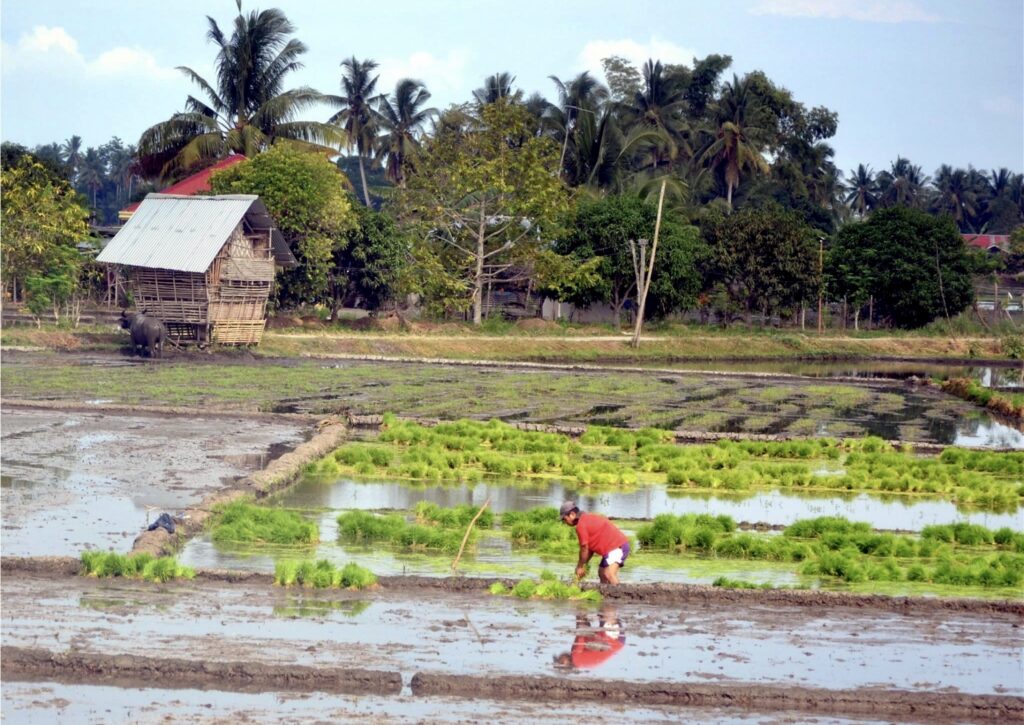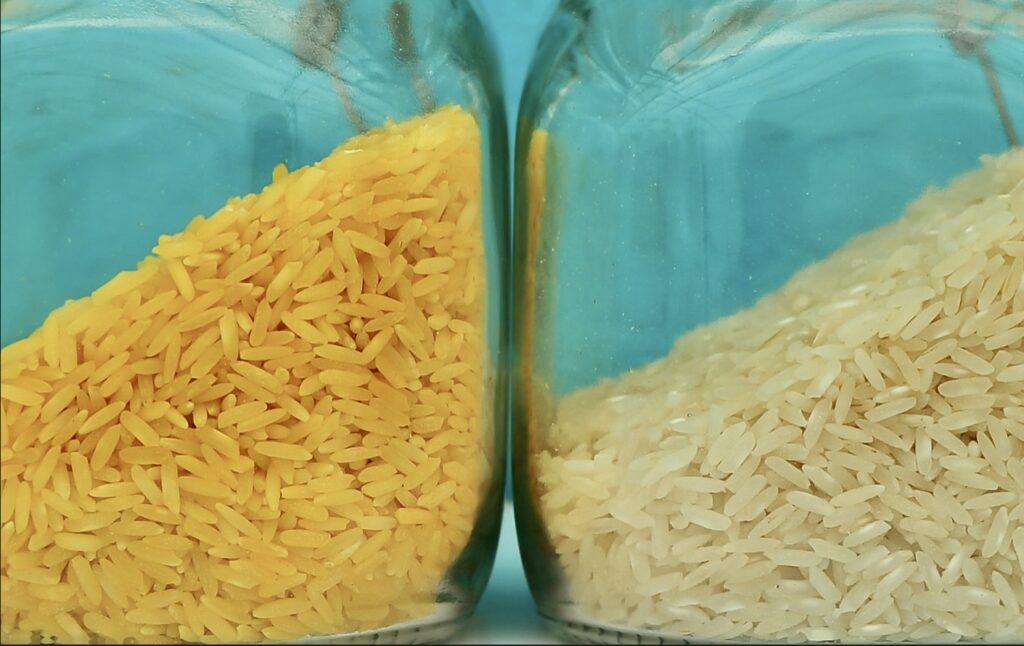Text by Henrylito D. Tacio
Photos: IRRI
Expect Filipino farmers planting golden rice in their farms as the genetically modified crop has already been approved for commercial production – more than two decades after it was created.
“Filipino farmers will become the first in the world to be able to cultivate a variety of rice enriched with nutrients to help reduce childhood malnutrition,” announced the Laguna-based International Rice Research Institute (IRRI).
The announcement came after a biosafety permit was issued by government regulators, thus paving the way for the rice to be grown by farmers across the country. The permit stipulates that golden rice has “undergone satisfactory biosafety assessment pursuant to Department of Science and Technology, Department of Agriculture, Department of Environment and Natural Resources, Department of Health, and Department of Interior and Local Government Joint Department Circular No. 1, Series of 2016.”
Of the issuance of the permit, IRRI Director General Dr. Jean Balie said, “This milestone puts the Philippines at the global forefront in leveraging agriculture research to address the issues of malnutrition and related health impacts in a safe and sustainable way.”
Golden rice was first conceived by Professors Ingo Potrykus and Peter Beyer in the late 1980s. IRRI, which became the first licensee of the scientists’ work in 2001, spent two decades working with the Philippine Rice Research Institute (PhilRice) of the Department of Agriculture (DA).
“The regulatory success of golden rice demonstrates the research leadership of DA-PhilRice and the robustness of the Philippine biosafety regulatory system,” Dr. Balie added.
Golden rice is a type of rice that contains beta carotene (pro-vitamin A, a plant pigment that the body converts into vitamin A as needed). This compound is what gives this grain its yellow-orange or golden color, hence its name.
Golden rice is a production of biotechnology, particularly genetic engineering. “While ordinary rice does produce beta-carotene, it is not found in the grain,” IRRI explained. “Thus, scientists used genetic engineering to add the compound to the grain – a minor tweak that improved the grain’s nutritive value.”
The beta-carotene in golden rice, which was made possible by the addition of two new enzymes, is identical to the beta-carotene found in green leafy (malunggay, for instance) and yellow-colored vegetables (carrot and squash), orange-colored fruits (mango and papaya), and even in many vitamin supplements and food ingredients.
While golden rice is an enhanced version of ordinary rice, it comes without any additional cost or difference in taste.
“While golden rice is expected to cost and taste the same as regular rice, its beta-carotene content makes it a valuable asset in the battle against vitamin A deficiency (VAD),” IRRI said. Vitamin A is an essential micronutrient for growth, development, and keeping the body’s visual and immune systems healthy.
VAD is one of the most important issues in terms of global public health, according to the World Health Organization (WHO). VAD weakens the body’s resistance to diseases and infections, causes blindness, and may even result in death if left untreated.

Golden rice with vitamin A-rich fruits 
Farmer planting rice 
Golden rice and white rice
One million of the 1.5 million blind children in the world live in Asia, according to a WHO study. “Each year, there are half a million new cases, 70 percent of which are due to vitamin A deficiency,” the authors wrote in 2001. At that time, the authors estimated that a child went blind somewhere in the world every minute. Worst of all, the study points out, the majority die within 12 months of losing their sight.
In the Philippines, VAD incidence continues to be a significant health issue affecting almost 17%, or 2 million children under the age of 5. This figure is based on the 2018 Expanded National Nutrition Survey of Food and Nutrition Research Institute of the Department of Science and Technology.
IRRI is very much aware that there are other approaches – such as vitamin A supplementation, food fortification, diet diversification, and promotion of optimal breastfeeding – which have made successes in combating VAD.
“However, more work is necessary to address the needs of certain target populations, especially those in remote areas,” IRRI stated. “Additionally, millions continue to suffer from VAD to this day.”
In Asia, where rice is a staple food, golden rice is one of the best ways to cut the prevalence of VAD. A simulated analysis study suggests that beta-carotene-rich rice could improve vitamin A intake and could reduce the prevalence of VAD among women and children.
“It is clear that multiple approaches are required in fighting VAD. An additional tool in the toolbox such as golden rice – one that can be seamlessly integrated into the everyday lifestyles of even the poorest sectors of society – can be a concrete, sustainable solution to ensure proper nutrition,” IRRI said.
Just like other genetically engineered foods developed under strict regulation by experts, golden rice is safe to eat.
“Before any genetically modified foods become available in the market, they must pass rigorous safety assessments and must not demonstrate a high likelihood of putting human health at risk,” the IRRI explained.
In the case of golden rice, it had to go through a series of rigorous testing and regulatory procedures. To ensure that golden rice is safe for the environment and health, the planting materials used were subjected to confined field-testing in fenced and isolated areas for at least two cropping seasons in 3 different locations in the country.
“During the tests, any discrepancy or variation from the original variety in terms of appearance, and any unusual disease, pest, or weed incidence at the sites were carefully assessed,” said Dr. Reynante Ordonio, the PhilRice senior science research specialist.
The Biosafety Committee of the DOST provides overall supervision along with scientist representatives and members of the local community who jointly form the Institutional Biosafety Committee of each site; see to it that biosafety guidelines are strictly followed. Among these guidelines is preventing the intentional or unintentional release of viable seeds or plants from the site and the proper disposal or transport of transgenic materials.
Once the five best-performing lines of the planting materials are identified, these are to be forwarded to a season of field trials under the supervision of the DA-BPI as stated in the Joint Department Circular No. 1 Series of 2016 pertaining to the handling and use, transboundary movement, release, and management of genetically modified organisms (GMOs).
Aside from the two government agencies, other departments involved are the DENR, DOH, and DILG. This collaborative assessment further ensures the safety of golden rice.
Golden rice has the support of the vast majority of respected scientists with and without expertise in agricultural biotechnology. So far, 157 Nobel laureate scientists have backed golden rice for human consumption.
Global health authorities and government agencies around the world have also overwhelmingly endorsed the safety of GMOs. “In countries where GM foods have been approved, there have been no scientifically proven negative effects on human health due to consumption of GM foods,” IRRI said.
For Filipino farmers, the good news is: golden rice does not require any special cultivation practices. Like ordinary rice, golden rice “has the same yield and agronomic performance,” IRRI assured.
Russell Reinke, IRRI outcome theme leader of improving health through safe and nutritionally enhanced rice, said that “limited quantities” of golden rice seeds could be distributed to Filipino farmers in selected provinces next year.
For its part, PhilRice has started working with local partners to identify market- and program-based approaches for bringing golden rice first to selected communities with a high prevalence of VAD and other associated micronutrient deficiencies.
“We are committed to ensuring the highest quality of seed for farmers and a safe and nutritious food supply for all Filipinos,” said Dr. John de Leon, PhilRice executive director.

